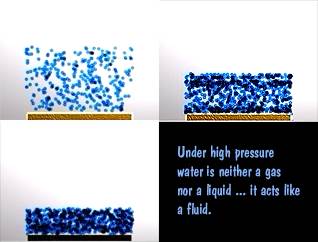Rocks contain small cracks and pores from their initial formation. Igneous rocks crack around grain boundaries due to differential speeds in cooling. Sedimentary rocks have large grain boundaries due to the cementation process that created them. These porous areas often contain water with dissolved gases and rock constituents.
The liquid contained in these cavities is called intergranular fluid. The intergranular fluid provides a ready pathway to redistribute the chemistry of the rock in an efficient manner. Without the fluids, ions must migrate through solid materials and this is a VERY SLOW process, even on a geologic time scale.
Some of the fluids may have been present form the time the rock was created. Some rock may be deformed via tectonic forces (bending, folding, cracking, etc.) and the fluids may have been introduced later. Regardless of how the fluid phase arrives, it provides a ready path for the metamorphic process and makes it happen at highly accelerated rates.
When this fluid finds large fissures or cracks in the rock it can easily migrate from place to place. During the migration is may precipitate one or more of the minerals it has dissolved. This process can lead to "veining" in the rock. A vein is the mineral path taken by a fluid while it precipitate all or part of it soluble load.

When water is sufficiently heated it will boil. the process is simply the change of state from a liquid to a gas. If the water is heated in a confined space, then the boiling action will also increase the pressure of the system.
Combine with the natural high pressure at depth and apply substantially more heat, and the water is first boiled, but under the limited volume and high pressure it changes from a gas to a "fluid" state. The fluid has neither the properties of the liquid or the gas vapor.
It has the same or higher density than the liquid, so it is a very effective solvent, but at extremely high temperature and is thus far more active.
A prograde metamorphic process is one that happens when temperature and pressure are rising and intergranular fluids are present. (EVEN SMALL AMOUNTS OF FLUID ARE SUFFICIENT FOR THIS TYPE OF REACTIVITY.) (Remember a larger amount of fluid might cause remelting and the rock type would then turn again to igneous.)
A retrograde metamorphic process occurs when temperature and pressure are falling and the fluid level has been decreased. Usually because it (the fluid) has already been driven out of the area.
Retrograde reactions happen VERY SLOW because they are more solid state. As a result, metamorphic rocks that reach the earths surface and were caused by high-grade metamorphic processes are more stable and last long enough to observe.
Pressure is felt throughout a rock almost instantly. Pressure is passed rapidly through solids, for instance sound wave pass through solids much faster than they do through air. Sound wave are after all simply pressure waves. Example: the old trick of putting your ear on a railroad track allows you to hear an approaching train far earlier than if you wait to hear it in the air.
Temperature must use conduction to move through solid rock and is a slower process in solids. That is why some kinds of minerals are used to make kiln bricks. They are very non-conductive, and heat passes through them slowly. Same with the space shuttle. The wings are coated with temperature resistant ceramics.
For this reason, a large rock body will feel the pressure of its depth far sooner than it will be heated by the temperature at its depth. Take home story: metamorphic rocks near continental subduction zones will see higher pressure due to plate tectonics before they are heated to their hottest temperature due to burial. Thus there is an offset between the highest temperature they see and the highest pressure to which they are subjected. By the time they see the highest temperature they are already in a lowerer pressure zone.
SO ... if we can measure the age of a metamorphic rock more than once along its P-T curve, we can calculate a rate of subduction. (How fast they are being buried and how fast they are rising.)
| NEXT | TOC | PREV |